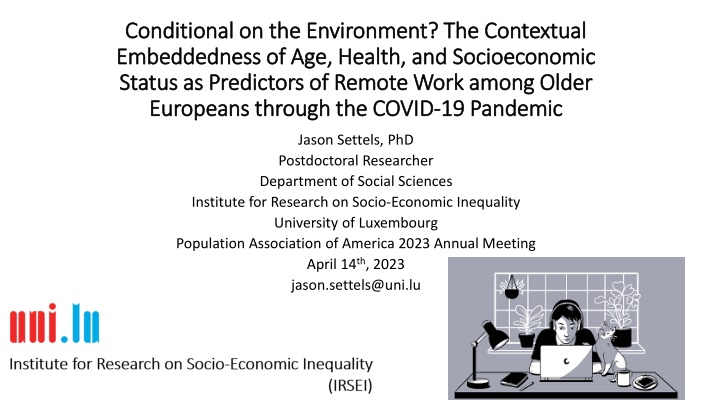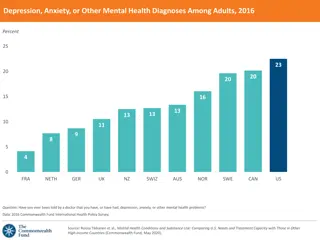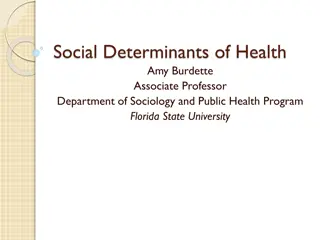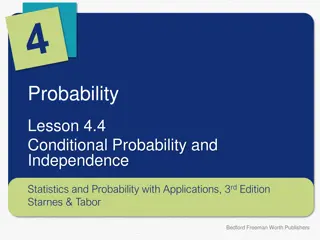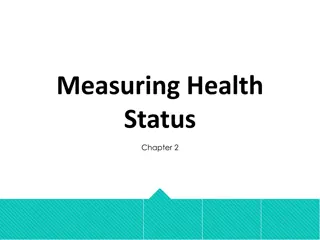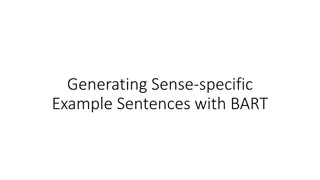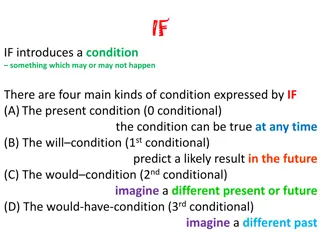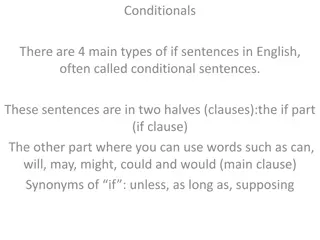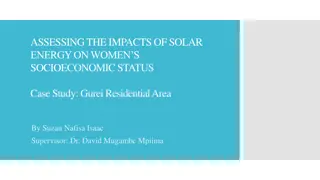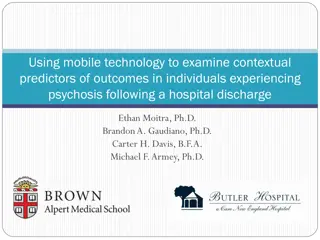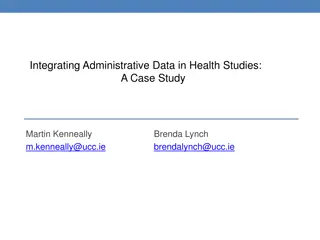Conditional on the Environment? The Contextual Embeddedness of Age, Health, and Socioeconomic Status as Predictors of Remote Work among Older Europeans through the COVID-19 Pandemic
This study delves into how the COVID-19 pandemic has influenced remote work patterns among older Europeans, focusing on the interaction between age, health, socioeconomic status, and contextual factors. It explores the impact of government restrictions, education, income, age, and health on the ability to work remotely during the pandemic, offering insights for future epidemic responses.
Download Presentation

Please find below an Image/Link to download the presentation.
The content on the website is provided AS IS for your information and personal use only. It may not be sold, licensed, or shared on other websites without obtaining consent from the author.If you encounter any issues during the download, it is possible that the publisher has removed the file from their server.
You are allowed to download the files provided on this website for personal or commercial use, subject to the condition that they are used lawfully. All files are the property of their respective owners.
The content on the website is provided AS IS for your information and personal use only. It may not be sold, licensed, or shared on other websites without obtaining consent from the author.
E N D
Presentation Transcript
Conditional on the Environment? The Contextual Conditional on the Environment? The Contextual Embeddedness of Age, Health, and Socioeconomic Embeddedness of Age, Health, and Socioeconomic Status as Predictors of Remote Work among Older Status as Predictors of Remote Work among Older Europeans through the COVID Europeans through the COVID- -19 Pandemic 19 Pandemic Jason Settels, PhD Postdoctoral Researcher Department of Social Sciences Institute for Research on Socio-Economic Inequality University of Luxembourg Population Association of America 2023 Annual Meeting April 14th, 2023 jason.settels@uni.lu 1
Introduction Introduction The COVID-19 pandemic is a global medical crisis announced by the World Health Organization (WHO) in January 2020 as a Public Health Emergency of International Concern (Metelmann and Busemann 2020). COVID-19-era lockdown measures restricted many individuals from working from their usual locations (Russo et al. 2021). The economic and well-being impacts of these remote work arrangements (B land, Brodeur, and Wright 2020; Dubey and Tripathi 2020), beyond containment of the COVID-19 virus spread. Negotiations between employees and employers concerning remote work arrangements (Davies 2021; Fana et al. 2020). Lack of research on heterogeneity in how personal characteristics predicted working remotely based on contextual factors. This knowledge will help prepare responses to future large-scale epidemics. 2
Research Research Questions Questions How did country-level digitization stringency of government restrictions health impacts of COVID-19 moderate the relationships of individual-level education and household income (measures of socioeconomic status) age general health with pandemic-era remote work? 3
Previous Research, Conceptual, and Theoretical Previous Research, Conceptual, and Theoretical Framework Framework Discussions of individual-level predictors of remote work: education, occupations, and types of work (Dingel and Neiman 2020) age and health (Camacho-Rivera, Islam, and Vidot 2020) Discussions of contextual-level predictors of remote work: general extents of socioeconomic status (Kavanagh, Goel, and Venkataramani 2021) workforce involvement of advanced computer technologies (Sostero et al. 2020) pandemic-era health burdens (Brynjolfsson et al. 2020) 4
Previous Research, Conceptual, and Theoretical Previous Research, Conceptual, and Theoretical Framework Framework Theoretical perspectives: fundamental cause theory of health, see Link and Phelan (1995) and Phelan et al. (2010) health belief model, see Abraham and Sheeran (2015) Plausible Cross-Level Interactions and Associated Hypotheses: I expect that among older Europeans working continuously through the pandemic, the positive associations of education and income with remote work are reduced by societal digitalization (H1.1). I expect that among older Europeans working continuously through the pandemic, the positive associations of more advanced age and worse health with remote work are increased by societal digitalization (H1.2). 5
Previous Research, Conceptual, and Theoretical Previous Research, Conceptual, and Theoretical Framework Framework I expect that among older Europeans working continuously through the pandemic, the positive associations of education and income (H2.1), and more advanced age and worse health (H2.2), with remote work are reduced by more stringent government containment measures. I expect that among older Europeans working continuously through the pandemic, the positive associations of education and income with remote work are increased by greater contextual COVID-19 health impacts (H3.1). I expect that among older Europeans working continuously through the pandemic, the positive associations of more advanced age and worse health with remote work are increased by greater contextual COVID-19 health impacts (H3.2). 6
Methods Methods Dataset: the Survey of Health, Ageing and Retirement in Europe s (SHARE) first COVID-19 module Constituent interviews across 27 nations of Europe and Israel took place between June and August 2020, thus at the height of the COVID-19 crisis and lockdowns. Sample: this study s sample were 50-89 years of age during the first COVID-19 module and were employed when the pandemic began (N=8,121). 7
Methods Methods Due to non-available country-level data on the European Commission s Digital Economy and Society Index, Israel and Switzerland were the only countries excluded. Because they were not assessed within the SHARE s first COVID-19 module, some required variables were obtained from other SHARE waves. Variables Dependent variable: Employment circumstances: worked at the usual workplace (reference category), worked at home and at the usual workplace, and worked only at home 8
Methods Methods Independent variables, individual-level: -age (50 to 89 years) -self-perceived pre-pandemic health: - good/very good/excellent (ref.) - poor/fair - years of education - 20 quantiles of household income, computed separately within each nation 9
Methods Methods Independent variables, country-level: -Digital Economy and Society Index (DESI), year 2020, (European Commission 2021) -stringency index (Our World in Data 2021) -excess mortality (EM) p-scores (Karlinsky and Kobak 2021) 10
Methods Methods Control variables, individual-level: -gender -marital/relationship circumstances -parental status -self having been infected with COVID-19 -a close contact having been infected with COVID-19 Control variables, country-level: -median age of the population in 2020 (Eurostat 2021) -GDP per capita in 2020 (World Bank Group 2022) 11
Methods Methods Analysis The focus is on three sets of multinomial logistic regressions, one for each country-level independent variable: -DESI -stringency index -EM p-scores Within each set are four models, in which the respective country-level independent variable is sequentially studied in interaction with each individual-level independent variable: -age -self-perceived health -years of education -20 quantiles of household income 12
Methods Methods Missing data were dealt with through multiple imputation using chained equations. All models were weighted with the SHARE s survey weights. Standard errors were adapted for clustering according to country of residence during the first COVID-19 module. 13
Results Results Figure 1. Predicted Probabilities of Working Only from Home, DESI in Interaction with Years of Education, 95% Confidence Intervals Included 14
Results Results Figure 2. Predicted Probabilities of Working Only from Home, Excess Mortality P- Scores in Interaction with Years of Education, 95% Confidence Intervals Included 15
Results Results Figure 3. Predicted Probabilities of Working Only from Home, Excess Mortality P- Scores in Interaction with Self-Perceived Health, 95% Confidence Intervals Included 16
Discussion Discussion Additional finding: greater stringency of government pandemic response reduced the positive association of household income, but not education, with working partly remotely among continuously working older Europeans. The most substantial findings are for working completely from home. H1.1 partially supported: among older continuously working Europeans, the positive impact of education, but not household income, upon fully remote work was reduced within more digitalized nations. Implications for the fundamental cause theory of health. 17
Discussion Discussion H1.2 not supported: no consistent patterns of the effects of age or of self-perceived health being significantly moderated by societal digitalization. In partial support of H2.1 and in contradiction of H2.2, greater stringency of government pandemic response only reduced the positive association of household income with working partly remotely among continuously working older Europeans. H3.1 partially supported: among older Europeans continuing to work through the pandemic, education, but not household income, was more strongly positively associated with working completely remotely within nations undergoing more excess mortality. 18
Discussion Discussion H3.2 partially supported: worse self-perceived health, but not more advanced age, was positively moderated by country-level excess mortality in its predictions of partially and fully remote work among older Europeans continuously working through the pandemic. Implications for the health belief model. 19
Discussion Discussion Theoretical Implications Fundamental Cause Theory of Health More focus on geographical variations. The importance of unpredictable chance events. Health Belief Model Beyond the individual level, the COVID-19 pandemic exemplifies how this model also applies at the structural levels of work organizations and governments (meso and macro levels). 20
Discussion Discussion Policy Implications Especially within national circumstances of lower digitalization and/or greater health impacts, further provisions should be made for remote work and/or more sanitary employment environments, particularly for workers with less education, whose choices will be further restricted. Moreover, especially among those with less education, policies and programs should help older adults with fewer skills with information, communication, and internet technologies in acquiring these capabilities (Seifert et al. 2021). Governments and employers should give priority to those in worse health when making decisions concerning work arrangements. 21
Thank you for your attention! jason.settels@uni.lu 22
References References Abraham, Charles, and Paschal Sheeran. 2015. "The health belief model." Pp. 28-80 in Predicting health behaviour: Research and practice with social cognition models, edited by M. Conner and P. Norman. Buckingham, United Kingdom: Open University Press. B land Louis-Philippe, Abel Brodeur, and Taylor Wright. 2020. Covid-19, stay-at-home orders and employment: evidence from CPS data. IZA Discussion Paper (13282): 1-110. Brynjolfsson, Erik, John J. Horton, Adam Ozimek, Daniel Rock, Garima Sharma, and Hong-Yi TuYe. 2020. COVID-19 and remote work: an early look at US data. NBER Working Paper Series (27344): 1-25. Camacho-Rivera, Marlene, Jessica Y. Islam, and Denise C. Vidot. 2020. Associations between Chronic Health Conditions and COVID-19 Preventive Behaviors among a Nationally Representative Sample of U.S. Adults: An Analysis of the COVID Impact Survey. Health Equity 4(1): 336 44. Davies, Amanda. 2021. COVID-19 and ICT-Supported Remote Working: Opportunities for Rural Economies. World 2(1):139 52. Dingel, Jonathan I., and Brent Neiman. 2020. How Many Jobs Can Be Done at Home? Journal of Public Economics 189: 1-8. Dubey, Akash Dutt, and Shreya Tripathi. 2020. Analysing the Sentiments towards Work-From-Home Experience during COVID- 19 Pandemic. Journal of Innovation Management 8(1): 13 19. European Commission. 2021. DESI composite index. Retrieved June 27, 2021. Eurostat. 2021. Population structure indicators at national level. Retrieved Oct. 2, 2021. Fana, Marta, Santo Milasi, Joanna Napierala, Enrique Fernandez-Macias, and Ignacio Gonz lez V zquez. 2020. Telework, work organisation and job quality during the COVID-19 crisis: a qualitative study. No. 2020/11. JRC Working Papers Series on Labour, Education and Technology. 23
References References Karlinsky, Ariel, and Dmitry Kobak. 2021. Tracking Excess Mortality across Countries during the Covid-19 Pandemic with the World Mortality Dataset. ELife 10. Kavanagh, Nolan M., Rishi R. Goel, and Atheendar S. Venkataramani. 2021. County-Level Socioeconomic and Political Predictors of Distancing for COVID-19. American Journal of Preventive Medicine 61(1): 13 19. Link, Bruce G., and Jo Phelan. 1995. "Social conditions as fundamental causes of disease." Journal of health and social behavior extra issue: 80-94. Metelmann, Isabella B., and Alexandra Busemann. 2020. "Elective surgery in times of COVID-19: A two-centre analysis of postponed operations and disease-related morbidity and mortality." Zeitschrift f r Evidenz, Fortbildung und Qualit t im Gesundheitswesen 158: 62-65. Our World in Data. 2021. Stringency Index. Retrieved Oct. 2, 2021. Phelan, Jo C., Bruce G. Link, and Parisa Tehranifar. 2010. Social Conditions as Fundamental Causes of Health Inequalities: Theory, Evidence, and Policy Implications. Journal of Health and Social Behavior 51(1_suppl):S28 40. Russo, Daniel, Paul H. P. Hanel, Seraphina Altnickel, and Niels van Berkel. 2021. Predictors of Well-Being and Productivity among Software Professionals during the COVID-19 Pandemic a Longitudinal Study. Empirical Software Engineering 26(4): 1-63. Seifert, Alexander, Shelia R. Cotten, and Bo Xie. 2021. A Double Burden of Exclusion? Digital and Social Exclusion of Older Adults in Times of COVID-19. The Journals of Gerontology. Series B, Psychological Sciences and Social Sciences 76(3):e99 103. Sostero, Matteo, Santo Milasi, John Hurley, Enrique Fernandez-Macias, and Martina Bisello. 2020. Teleworkability and the COVID-19 crisis: a new digital divide?. No. 2020/05. JRC working papers series on labour, education and technology. World Bank Group. 2022. GDP per capita (current US$). Retrieved April 21, 2022. 24
